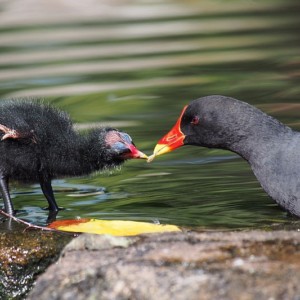#BOU2022 – Keynotes

Nests, eggs and chicks: reproduction in a changing world
12 – 14 April 2022
ON ZOOM AND TWITTER
Alfred Newton Lecture
 Cuckoos and curious naturalists
Cuckoos and curious naturalists
Prof Nick Davies
University of Cambridge, UK
“Scarcely any bird has had so many idle tales” wrote Alfred Newton in a paper on “Cuckow’s eggs”, published in 1869 in the first volume of Nature. An early champion of Darwin’s theory of natural selection, Newton suggested that cuckoo egg mimicry has evolved to deceive hosts and he coined the term “gens” to denote a race of cuckoo that specialised on one particular host species. We now have experimental evidence for how cuckoos trick their hosts not only by mimetic eggs, but also by rapid and secretive laying, and by manipulative begging of cuckoo chicks. We also know that host defences are costly and that hosts vary their defences in relation to perceived parasitism risk, assessed by both personal and social information. In this talk I pay tribute to past curious naturalists, especially Edward Jenner and Edgar Chance, whose brilliant field observations paved the way for current experimental studies, and I raise some puzzles, for example: why do some cuckoos get away with non-mimetic eggs? and why don’t hosts of the common cuckoo reject cuckoo chicks, as do some hosts of Australian cuckoos? There is wonderful natural history for future curious naturalists.
Nick has been a member of the BOU for over fifty years and sits at Alfred Newton’s old desk in his room in the Zoology Department at Cambridge, where he is Emeritus Professor of Behavioural Ecology and Fellow of Pembroke College. He and his colleagues have studied cuckoo-host interactions for the last thirty five years. His book Cuckoo – cheating by nature is published by Bloomsbury.
Keynote presentations
 Why do eggs fail? Infertility, prenatal mortality, and implications for bird conservation
Why do eggs fail? Infertility, prenatal mortality, and implications for bird conservation
Nicola Hemmings
Department of Animal & Plant Sciences, University of Sheffield, UK
@hemmingsnicola1 & @sheffieldAPS
Hatching failure is a major problem for many threatened bird species. Identifying the mechanisms underpinning hatching failure is therefore key to establishing effective conservation interventions. In this talk, I will summarise our current understanding of the causes of hatching failure in birds, presenting data on the relative importance of infertility and prenatal mortality across a range of wild and managed populations, including both threatened and non-threatened species. I will highlight the importance of distinguishing fertilisation failure from prenatal mortality, both for practical conservation purposes and for our broader understanding of demographic and evolutionary dynamics. Finally, I will consider what unhatched eggs can’t tell us: how much do we really know about variation in fertility in wild birds, and how can we fill the gaps in our knowledge?
Nicola is a Royal Society Dorothy Hodgkin Research Fellow in the Department of Animal & Plant Sciences, University of Sheffield. She studies the reproductive behaviour and physiology of birds, working with conservation practitioners to apply insights from reproductive biology to conservation management. Nicola also has a strong interest in public engagement with science and is involved with several projects aimed at fostering closer connections between people and nature in the UK.
 Biorhythms and incubating shorebirds
Biorhythms and incubating shorebirds
Dr Martin Bulla
Max Planck Institute for Ornithology, Germany
Czech University of Life Sciences Prague, Czech Republic
The behavioural rhythms of organisms are thought to be under strong selection, influenced by the rhythmicity of the environment. Such behavioural rhythms are well studied in isolated individuals under laboratory conditions, but free-living individuals have to temporally synchronize their activities with those of others, including potential mates, competitors, prey and predators. Individuals can temporally segregate their daily activities (for example, prey avoiding predators, subordinates avoiding dominants) or synchronize their activities (for example, group foraging, communal defence, pairs reproducing or caring for offspring). It is thus essential to study individuals in their natural environment and realistic social settings. I will first present diversity and potential drivers of incubation rhythms in biparental shorebirds, i.e. in species where both parents have to synchronize their diel rhythms, because only one parent can incubate at any time and eggs need continuous parental presence. Then, I will highlight the open questions about biparental incubation and present an attempt to answer such questions using captive red knots. Finally, I will present our ongoing work on incubation rhythms of uniparental shorebirds, i.e. work on individual rhythms in the absence of social synchronization.
Martin studied incubation of Semipalmated Sandpipers, as well as global variation in incubation rhythms of biparentally incubating shorebirds for his PhD at Max Planck Institute for Ornithology. He then worked at the Royal Netherlands Institute for Sea Research investigating biorhythms of Red Knots and is currently a postdoc at Max Planck Institute for Ornithology and at Czech University of Life Sciences, Prague, where he investigates global variation in incubation rhythms of uniparentally incubating shorebirds.
 Intergenerational effects of parental state on offspring fitness
Intergenerational effects of parental state on offspring fitness
Prof Pat Monaghan
Institute of Biodiversity, Animal Health and Comparative Medicine, University of Glasgow, UK
Conditions experienced in early life can have long term consequences for individual fitness. These can arise as a consequence of a direct effect on phenotypic development, or indirect effects operating through the developmental environment parents provide for their offspring. My focus in this talk will be on the latter, and particularly on effects operating through the mother. Maternal state is affected by extrinsic factors such as nutrition levels or stress exposure, and intrinsic factors such as age. In birds, effects linked to maternal state can occur pre-natally, for example due to effects on offspring sex ratios, egg composition and embryonic development during incubation, as well as the more obvious post-natal effects arising from the quality of parental care. I will discuss a number of such processes which we have investigated in both wild and captive bird species. I will also discuss some of the proximate mechanisms that may underpin both the nature of the effects and how long they last, such as changes to offspring growth rates, stress responses, telomere lengths and mitochondrial function. I will also discuss whether or not such effects might be adaptive.
Pat is an evolutionary ecologist, based at the University of Glasgow, where she holds the Regius Chair in Zoology. She did her PhD at Durham University on seabird ecology, followed by work on the interactions between seabirds and fisheries management. She then began research on the effect of early life conditions in shaping individual life histories, involving studies at many different biological levels from physiology and molecular biology to ecology and behavioural biology. Her work is mainly on birds, involving lab-based and field studies, with related work in other taxa.

The effect of phenological asynchrony on fitness in Blue Tits
Dr Ally Phillimore
University of Edinburgh, UK
@AlbertPhillimo2
The implications of rising spring temperatures for feeding interactions has generated a lot of recent interest, with the timing of nesting of woodland insectivore birds in relation to their caterpillar resource widely used as a system to test the effects of trophic asynchrony on fitness. For eight years we have been collecting data on caterpillars and blue tits from 44 woodland sites in Scotland, with the aim of examining whether trophic asynchrony and its consequences for birds varies among habitats. Most previous work on this this type of woodland food chain has tempted to lump all caterpillars together or assume that one or two species, such as the winter moth, predominate. By adopting a metabarcoding approach which we’ve applied to faecal samples obtained from nestlings we have been able to gain a very detailed insight into what the nestlings are being fed. We find that moth caterpillars do comprise the majority of the resource, with Geometrids and particularly winter moths especially preferred. Our next step involves examining how the phenological distribution (i.e. timing, abundance and duration) of woodland caterpillars in relation to the timing of blue tit breeding impacts on the ability of birds to fledge young. Finally, by identifying the effects of temperature on the phenological distribution of woodland caterpillars, we are aiming to get a more complete picture of whether rising spring temperatures will exacerbate the impacts of trophic asynchrony on woodland passerines.
After a PhD at Imperial College, London, Ally was awarded a NERC advanced research fellowship which he took to Edinburgh University, where is now a Reader. The main focus of his group’s research is on how climate change impacts the phenology of different plant and animal species and the knock-on effects for species interactions. Since 2014 he has been running the Phenoweb project that looks at a woodland food web composed of trees, caterpillars and blue tits at 44 sites in Scotland.

The impact of parasitism within the family
Dr Emma Cunningham
University of Edinburgh, UK
Parasites are a ubiquitous component of all animal populations. Some infections may be acute and short-lived but more commonly, individuals experience on-going chronic levels of infection that impact on host life-history traits throughout life. The impact of infection is likely to be particularly acute during reproduction when energetic demands are high for both parents working hard to raise a family and offspring in rapid phases of growth. However, this is also a time when costs may be passed on to different family members, leading to indirect costs of infection on individuals other than the primary host. How this plays out across the family can shape both responses to infection and other key life-history traits across an individual’s life. In this talk, I report on seventeen years of data on the impact of parasitism in a long-term study of seabirds, The European Shag. Both novel techniques to measure natural levels of parasitism and experimental manipulations of parasite burden have demonstrated that responses to parasitism are shaped in early life but can impact on different family members in the longer term in very different ways. Family members also differ in their sensitivity to how responses to parasitism play out across different environmental conditions. Quantifying how these ultimately link to breeding success over both the short and the long term is therefore a major part of understanding how predicted environmental shifts may impact both infection dynamics and their impact on host populations.
Following a PhD at Sheffield University, Emma held a Dorothy Hodgkin Research Fellowship at the University of Cambridge, and then a post-doctoral research post at the University of California Santa Barbara. She then returned the UK as a Royal Society University Research Fellow at the University of Edinburgh, where she now holds a lectureship. Her research group works on the evolution and ecology of reproduction and disease – in particular, how early life conditions affect an individual’s ability to deal with parasitism and infection.
 Giving waders a headstart
Giving waders a headstart
Dr Lynda Donaldson
Wildfowl & Wetlands Trust, UK
@donaldsonlynda1
Populations of wader species are in decline in many parts of the world due to threats such as habitat loss and degradation from agricultural intensification, reclamation, pollution and climate change, unsustainable hunting practices, and increasing levels of predation. These pressures leave breeding waders unable to successfully hatch and fledge adequate numbers of chicks, and maintain sufficient levels of juvenile and adult survival, to sustain viable populations in the long-term. Conservation efforts to help reverse these trends are often not immediately apparent or well-established, and can take time to implement and yield improved population trends. In this time, critically small populations are vulnerable to extinction. During this talk I will discuss a technique known as headstarting, which involves hatching wild eggs in captivity and releasing chicks back into the wild at fledging age. I will show how this tool has been developed and applied to assist threatened populations of waders by boosting productivity at the local and global level, using examples of projects involving the black-tailed godwit (Limosa limosa limosa), Eurasian curlew (Numenius arquata) and spoon-billed sandpiper (Calidris pygmaea), and highlight the challenges and opportunities of this technique for wader population recovery.
Lynda is a Principal Research Officer in the Conservation Evidence department at the Wildfowl and Wetlands Trust (WWT). She completed her PhD at the University of Exeter on wetland conservation at the landscape scale in East Africa, helping identify practical conservation solutions for securing viable populations of threatened species. Her current research focuses on close order management techniques for wetland species recovery, including the design and effectiveness of translocation projects.

Avian Reproduction special themed issue of IBIS
This is advance notice that we will be seeking papers from both within the conference programme and other researchers working in this area for a special themed issue of IBIS. More details about submission and deadline (likely to be mid-2022) to follow.
Scientific Programme Committee
Ian Hartley | University of Lancaster, UK (Chair)
José Alves | University of Aveiro, Portugal & BOU Meetings Committee
Sarah Burthe | UK Centre for Ecology & Hydrology
Becky Laidlaw | University of East Anglia, UK
Rob Robinson | BTO & BOU Meetings Committee, UK
Image credit: Top right, Common Moorhen feeding chick Francis C. Franklin CC BY SA 4.0 Wikimedia Commons

